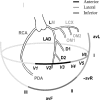The relation of QT dispersion and localized QT difference to coronary pathology in a population with unstable coronary artery disease
- PMID: 12848810
- PMCID: PMC6932660
- DOI: 10.1046/j.1542-474x.2003.08105.x
The relation of QT dispersion and localized QT difference to coronary pathology in a population with unstable coronary artery disease
Abstract
Background: QT dispersion (QTd) contains prognostic information in several patient groups. The variable increases in several conditions with ischemia. Originally, it was thought to reflect the local repolarization inhomogeneity. Even though this explanation has been questioned lately, it continues to be put forward. In order to elucidate a possible local mechanism, we investigated the relation between QT dispersion, an ECG parameter reflecting the local dispersion, and angiographical measures in a population with unstable coronary artery disease.
Methods: The 276 patients were recruited from the FRISC II trial. As the QTd parameter we used the mean value of automatically measured QTd during 27 hours after admission (QTdMean). As a local repolarization measure we used the maximal difference in QT between two adjacent ECG leads (QTdiffMean). The computations were performed on all available ECG leads and on a restricted set without the V1-V2 combination. Previously published angiographic scoring tools were adapted for rating and localizing the coronary pathology by two approaches and applied on 174 patients undergoing angiography.
Results: QTdMean was significantly higher than that reported in previous material with unselected chest pain patients (55 vs 40 ms). QTdiffMean correlated strongly with QTdMean. No differences in QTdMean were detected between patients with different angiographical scores. No relation could be shown between the region with dominating coronary pathology as expressed by the scoring tools and the localization of QTdiffMean.
Conclusions: QTd in ischemia seems to be increased by a mechanism unrelated to localization and severity of coronary disease.
Figures
Similar articles
-
Relation between QT dispersion and the extent of myocardial ischemia in patients with three-vessel coronary artery disease.Am J Cardiol. 1998 Mar 1;81(5):564-8. doi: 10.1016/s0002-9149(97)00975-2. Am J Cardiol. 1998. PMID: 9514450
-
Usefulness of automatic QT dispersion measurement for detecting exercise-induced myocardial ischemia.Anadolu Kardiyol Derg. 2009 Jun;9(3):189-95. Anadolu Kardiyol Derg. 2009. PMID: 19520652
-
The diagnostic value of QT dispersion for acute coronary syndrome in patients presenting with chest pain and nondiagnostic initial electrocardiograms.Mt Sinai J Med. 2006 Sep;73(5):813-7. Mt Sinai J Med. 2006. PMID: 17008945
-
Effect of coronary ischemia on QT dispersion.Prog Cardiovasc Dis. 2000 Mar-Apr;42(5):351-8. doi: 10.1053/pcad.2000.0420351. Prog Cardiovasc Dis. 2000. PMID: 10768313 Review.
-
[Measurement dispersion of the QT interval and its significance in different diseases].Pol Merkur Lekarski. 2001 Jul;11(61):52-5. Pol Merkur Lekarski. 2001. PMID: 11579833 Review. Polish.
Cited by
-
Admission N-terminal pro-brain natriuretic peptide and its interaction with admission troponin T and ST segment resolution for early risk stratification in ST elevation myocardial infarction.Heart. 2006 Jun;92(6):735-40. doi: 10.1136/hrt.2005.072975. Epub 2005 Oct 26. Heart. 2006. PMID: 16251228 Free PMC article.
References
-
- Dilaveris P, Andrikopuolos G, Metaxas G, et al. Effects of ischemia on QT dispersion during spontaneous anginal episodes. J Electrocardiol 1999;32: 199–206. - PubMed
-
- Michelucci A, Padeletti L, Frati M, et al. Effects of ischemia and reperfusion on QT dispersion during coronary angioplasty. Pacing Clin Electrophysiol 1996;19: 1905–1908. - PubMed
-
- Stierle U, Giannitsis E, Sheikhzadeh A, et al. Relation between QT dispersion and the extent of myocardial ischemia in patients with three‐vessel coronary artery disease. Am J Cardiol 1998;81: 564–568. - PubMed
-
- Yunus A, Gillis AM, Traboulsi M, et al. Effect of coronary angioplasty on precordial QT dispersion. Am J Cardiol 1997;79: 1339–1342. - PubMed
MeSH terms
LinkOut - more resources
Full Text Sources
Research Materials




